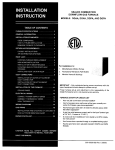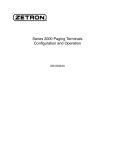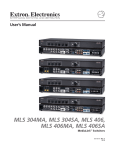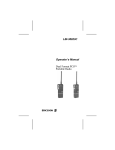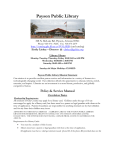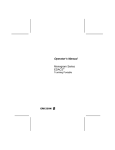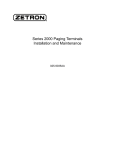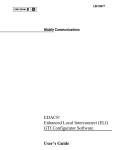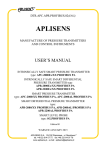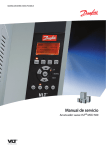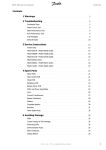Download ZETRON 2000 Series Specifications
Transcript
2000 Series Paging Terminals Configuration Guide Zetron, Inc. P.O. Box 97004 Redmond, WA 98073-9704 U.S.A. Contact Zetron for additional information on any product. Specifications are subject to change without notice. Telephone (425) 820-6363 Fax: (425) 820-7031 001-0131B Email: [email protected] Web: http://www.zetron.com October 1997 TABLE OF CONTENTS 1. OVERVIEW...............................................................................................................................................1 1.1 HOW TO USE THIS GUIDE ...................................................................................................................1 1.2 PAGING TERMINALS ............................................................................................................................2 2. PART TWO - STANDARD FEATURES ...................................................................................................3 2.1 PAGER CAPACITY ................................................................................................................................3 2.2 ALPHANUMERIC PAGING ....................................................................................................................3 2.3 VOICE MESSAGING ..............................................................................................................................5 2.4 VOICE PROMPTS ..................................................................................................................................5 2.5 TELCO PORTS.......................................................................................................................................6 2.6 TRANSMITTERS ..................................................................................................................................11 3. PART THREE - ADVANCED FEATURES .............................................................................................13 3.1 NETWORKING .....................................................................................................................................13 3.2 CALL ROUTING ...................................................................................................................................13 3.3 ALARM MONITORING .........................................................................................................................17 4. PART FOUR - SYSTEM ORDER GUIDE...............................................................................................20 4.1 VOICE CONTROLLER .........................................................................................................................20 4.2 CPU CHOICES .....................................................................................................................................21 4.3 HARD DISKS ........................................................................................................................................21 4.4 TERMINAL AND EXPANSION OPTIONS ............................................................................................21 4.5 INPUT POWER REQUIREMENTS.......................................................................................................23 5. PART FIVE - SYSTEM MANAGEMENT - PROGRAMMING, REPORTING, AND BILLING ................24 5.1 DO YOU WANT MULTIPLE USERS SIMULTANEOUSLY ACCESS THE ZBASE MANAGEMENT SOFTWARE?..............................................................................................................................................24 5.2 DO YOU WANT MULTIPLE AGENTS TO ACCESS ZBASE? .............................................................24 5.3 DO YOU WANT A REAL-TIME PRINT OUT OF EACH PAGE SENT?................................................24 5.4 DO YOU WANT AN ACCOUNTS-RECEIVABLE SYSTEM?................................................................24 6. PART SIX - SPARES .............................................................................................................................25 6.1 DO YOU WANT TO HAVE SPARE PARTS AVAILABLE? ...................................................................25 6.2 SPARES PARTS KIT............................................................................................................................25 6.3 INDIVIDUAL SPARE PARTS................................................................................................................25 7. PART SEVEN - INSTALLATION, POWER, AND PROTECTION..........................................................27 7.1 DO YOU HAVE LIGHTNING PROTECTION ON YOUR TELCO LINES?............................................27 7.2 CABLE ASSEMBLIES AND PUNCHDOWN BLOCKS .........................................................................27 7.3 DO YOU HAVE A BACKUP POWER SUPPLY? ..................................................................................27 7.4 WHAT KIND OF INPUT POWER WILL SUPPLY THE PAGING TERMINAL?.....................................27 8. PART EIGHT - PRE-INSTALLATION GUIDE........................................................................................28 8.1 OPERATING CONDITIONS .................................................................................................................28 8.2 MOUNTING ..........................................................................................................................................28 8.3 WIRING.................................................................................................................................................28 8.4 RADIO TRANSMITTER ........................................................................................................................28 8.5 PHONE LINES......................................................................................................................................29 8.6 MICROWAVE EQUIPMENT .................................................................................................................29 8.7 MAINTENANCE LINE...........................................................................................................................29 8.8 MANAGEMENT SOFTWARE...............................................................................................................29 8.9 IN SHOP TESTING...............................................................................................................................29 001-0131B October 1997 Page i PART ONE - OVERVIEW 1. OVERVIEW This guide is designed to help a paging system operator or dealer to consider all the requirements necessary to equip their proposed Zetron 2000 Series Paging Terminal to perform its specified functions. This guide also shows how the 2000 Series options relate to one another, and what requirements are important to be aware of when ordering these options. When used in conjunction with the 2000 Series product specification sheets, this Configuration Guide should be very helpful in deciding which 2000 Series options are necessary to meet a specific application. As always, Zetron applications engineers are happy to answer any additional questions that may arise. 1.1 HOW TO USE THIS GUIDE The Configuration Guide consists of eight sections: the Overview, Standard Features, Advanced Features, System Order Guide, System Management, Spares, Installation Power and Protection, and the Pre-Installation Guide. The Standard Features section contains the configuration and part number ordering information for all the standard terminal features such as pager capacity, alphanumeric paging, voice messaging/prompts, telco ports, and transmitter control. The Advanced Features section contains information about features that are only used in larger, more sophisticated systems. The advanced features include networking (TNPP and Outdial TAP), call routing (PathFinder), Alarm Monitoring, and redundant backup terminals (Standby System Controller). The System Order Guide section contains information about configuring the CPU, disk drives, and terminal model itself. This section should be completed after the previous sections, because determination of the overall system configuration is dependent on what features will be included. The Spares section contains information about the spares that are available for your terminal. The System Management section contains information on system management software that will allow you to configure and maintain your terminal and subscriber databases in the most effective way. The Installation, Power, and Protection section addresses miscellaneous parts and pieces such as connectors and punchdown blocks you may need during installation of your terminal. It also addresses lightning protection and backup power supplies. The Pre-Installation Guide contains a checklist of things to consider prior to installing your terminal. 001-0131B October 1997 Page 1 PART ONE - OVERVIEW 1.2 PAGING TERMINALS A typical paging terminal has a telephone input, a paging format encoder, a transmitter output, and some method for programming pager numbers into the system. The telephone input may be in the form of one or more trunks either from the telephone company’s central office, from a PABX, or even from a single telephone station. The transmitter(s) may be either remote or co-located, and paging may occur on more than one channel at a time. Programming may be done a personal computer. Additional features found on some paging terminals include voice storage that allows voice messages to be left for later retrieval or more than one voice page to be processed at a time, voice prompts to guide the caller through the paging process, and voice message retrieval for users to play back by telephone voice messages and pages that had been stored in the system. Numeric and alphanumeric display paging may be supported. Alphanumeric messages can be entered by a caller using a PC or through an operator-controlled device that is either on-site or is located remotely. Display pages also may be initiated by telephone or automated input from nurse call or monitoring systems that are interfaced to the paging terminal. Paging terminals can also be equipped to network with other paging terminals, allowing them to pass pages back and forth to each other to increase area coverage. Calls may be routed to external devices, such as mobile telephone interconnects or telephone answering consoles, to integrate paging and voice messaging with other services and to consolidate DID trunks onto one system. All of these functions are possible with the 2000 Series Paging Terminals, and are covered in this Configuration Guide. 001-0131B October 1997 Page 2 PART TWO - STANDARD FEATURES 2. PART TWO - STANDARD FEATURES 2.1 PAGER CAPACITY 2.1.1 What is the maximum number of pagers/phone numbers you expect to support? 2,000 3,000 4,000 5,000 6,000 7,000 8,000 9,000 10,000 11,000 12,000 13,000 14,000 15,000 16,000 17,000 18,000 19,000 20,000 25,000 30,000 35,000 40,000 45,000 50,000 The base terminal comes with 2000 subscribers. Subscribers are available in blocks of 1,000 (-X01) or 5,000 (-X50). The legal values are as follows: 2K, 3K, 4K, ..., 19K, 20K, 25K, 30K, 35K, ..., 50K. To go above 20,000 subscribers you must first buy to an even 5K increment with the -X01 option. If you plan to use an external system such as the Zetron ZAPP software to enter alphanumeric pages and send them to the terminal via TNPP then additional users do not have to be purchased for the terminal because the subscriber database is maintained by the ZAPP software. In other words, if you will be sending pages to the terminal using capcodes then the terminal’s database does not have to be programmed with user ID’s. 2.1.2 What will be the ratio of voice pagers to numeric/alphanumeric display pagers? 100% Voice / 0% Display 75% Voice / 25% Display 50% Voice / 50% Display 25% Voice / 75% Display 0% Voice / 100% Display 2.1.3 What pager formats do you want to support? 2 Tone 5/6 Tone HSC NEC D3 Multitone POCSAG 512 POCSAG 1200 POCSAG 2400 FLEX 1600 FLEX 3200 FLEX 6400 Other Golay 2.2 ALPHANUMERIC PAGING Alphanumeric messages allow subscribers to view complete text messages on their display pager, not just a phone number input by the caller. Alphanumeric paging is the mechanism that supports nurse call systems, alarm monitoring systems, and CAD systems. Generally these alphanumeric messages are sent to the paging terminal via a serial link connected on the other end to a device which can be used to type in the message. Sometimes these are dedicated devices for alphanumeric entry, and sometimes they are computers such as PCs running specialized software which generates the messages and sends them to the terminal. The 2000 Series paging terminal can accept these alphanumeric messages either (1) by modem over a telco line or (2) by direct serial connection (or both). If the alphanumeric entry device is located more than 150 feet from the paging terminal, it is recommended that the modem method be used as RS-232 serial data is unreliable over cables longer than 150 feet. 2.2.1 Do you want to transmit voice and numeric display pages from an operator controlled, desktop device that has a display? yes no You many want to learn more about the Zetron Model 103 Paging Entry Station (901-9152) which has an LED display, a numeric keypad, and a gooseneck microphone so that an operator can send pages without having to dial from a telephone. If desired, order one 2 wire analog telco card (950-9822) for every two Model 103’s to be used. 001-0131B October 1997 Page 3 PART TWO - STANDARD FEATURES 2.2.2 Alphanumeric Paging Software 2.2.2.1 Do you require alphanumeric paging software that supports large numbers of operators entering alphanumeric messages through a server PC? yes no The ZAPP! Alphanumeric Paging Program (950-9281) can support up to 24 operators whose PC workstations are connected to one server PC. The server PC interfaces to the 2000 Series paging terminal through either the Multiport Serial Interface Card or the Bi-Directional TNPP Network Interface Card. See the ZAPP! price and specifications sheets for additional information. 2.2.2.2 Do you require alphanumeric paging software for single or multiple users with PCs on a network? yes no The AlphaZ Alphanumeric Paging software (930-0001) is single-user software that runs on a PC running under DOS. A PC running AlphaZ interfaces to the 2000 Series either through a dial-up modem (the Dual Alpha Input Modem) or locally through the Multiport Serial Interface Card. See the AlphaZ price and specifications sheets for additional information. The AZNet Alphanumeric Paging software (930-0020 / 930-0021) is multiple-user software that runs on a PC running under DOS. A central “Gateway” PC takes data from all the PCs on the network and interfaces to the 2000 Series either through a dial-up modem (the Dual Alpha Input Modem) or locally through the Multiport Serial Interface Card. See the AZNet price and specifications sheets for additional information. Either of these pieces of software can be run in a DOS window under Windows 3.1, Windows ‘95, or Windows NT. 2.2.2.3 Do you want to support alpha input devices via dial-up modems? yes no If you will be supporting alpha input devices via dial-up modems, then you need to decide which trunk groups or phone lines will have modems. Modems are available for any one or any combination of the following: 1. Digital T1 span(s) 2. DID or E&M trunk group(s) 3. End-to-end line(s) 001-0131B October 1997 Page 4 PART TWO - STANDARD FEATURES 2.2.3 How many local alpha input devices do you want to support? none 1-2 3-4 5-6 7-8 9-10 11-12 13-14 15-16 17-18 19-20 21-22 23-24 25-26 27-28 29-30 31-32 33-34 35-36 37-38 39-40 41-42 43-44 45-46 47-48 49-50 51-52 53-54 55-56 57-58 This should include at least the following:: The number of nurse-call systems that will be connected via local serial ports The number of CAD systems that will be connected via local serial ports The number of local serial ports that will be supporting alphanumeric paging software Reference Section n/a # local serial ports n/a 2.2.2.1 2.2.2.1 TOTAL # local serial ports: The Multi-port serial card supports TAP inbound applications. It comes standard with 2 ports, and is expandable to 8 ports, by purchasing two ports at a time. Order the number of Multi-port serial cards (950-9196) and dual expansion ports (950-9197) needed to support the number of local serial ports specified above (i.e., if 10 ports are needed then order 2 multi-port serial cards and 3 dual-port expansions). 2.3 VOICE MESSAGING 2.3.1 Do you want to provide voice message retrieval service to subscribers? yes no The PageSaver option enables system operators to allow certain subscribers to have voice message storage and retrieval. If any of the call routing interconnect options in sections 3.2.3, 3.2.4, 3.2.5, 3.2.7, or 3.2.8 are needed, then this option should seriously be considered because it will provide forwarding on no answer to voice messaging. 2.3.2 How many subscribers do you expect to require voice message retrieval? none 1 to 600 (6 hour capacity: 950-9404) 601 to 2200 (12 hour capacity: 950-9332) 2201 to 4000 (24 hour capacity: 950-9333) 4001 to 8000 (48 hour capacity: 950-9336) 8001 to 12,000 (72 hour capacity: 950-9445) Order the PageSaver option in the size specified above. 2.4 VOICE PROMPTS 2.4.1 Do you want to provide Voice Prompts, instead of beeps, to the callers to help them through the calling process? yes no System Voice Prompts enables the 2000 Series paging terminal to give callers instructions while placing a page. They are recorded at the factory, but can be rerecorded over the telephone by the system operator. 2.4.2 Do you want to allow subscribers to customize their own prompts? yes no Subscriber recorded prompts enables system operators to allow certain subscribers to record their own custom voice prompts. 001-0131B October 1997 Page 5 PART TWO - STANDARD FEATURES 2.4.3 Voice Prompt Ordering Do not order these options if any PageSaver options (as specified in section 2.3.2) have been ordered. The voice prompt options are included with PageSaver. If specified in section 2.4.1, then order the System Voice Prompts (950-9069) option. If specified in section 2.4.2, order both the System (950-9069) and Subscriber (950-9127) recorded prompts options. 2.4.4 Do you want to have a mirrored disk that backs up system and client prompts? yes no 2.5 TELCO PORTS The number of telco ports installed in the paging terminal is adjustable. The telco ports are supported on either a digital T1 chassis which can handle up to 24 telco channels, or on analog telco port cards which can handle two telephone lines. Up to 2 digital T1 chassis or up to 29 telco cards can be installed in the terminal. These can be added at any time in the field. The number of telco ports calculated in this section can be adjusted by the customer based on their particular requirements. Or if desired, only some of the telco ports can be purchased as part of the initial system installation, and then additional telco ports can be purchased and added later as the system expands. 2.5.1 Number of Trunks to Support Paging An example of how to follow the calculations made in this section is included in section 2.5.1.4 to help clarify the equations and calculations described in this section. The calculations described in this section are primarily to demonstrate how the calculations for telco line traffic are done, and what the average usage rates for a paging terminal are. The values for things like the length of time a display page or voice page takes are estimates based on industry averages. For any particular installation, these values may vary. The customer should consider whether there are special circumstances which might cause the values shown in this document to be somewhat different. For example, if the customer plans to use the system for extensive voice paging, an average 15 second voice page might not be sufficient. Similarly, if the system is to be very heavily used, more than 25% of the system subscribers might receive a page during the terminal’s busiest hour. 2.5.1.1 What is the acceptable percentage of calls on which a caller might get a busy signal (known as “grade of service”) ? 1% or less 2% 5% 2.5.1.2 Determine the total offered telco traffic during busy hour for paging and messaging 2.5.1.2.1 Determine the offered telco traffic due to basic paging The average display page takes 12 seconds to be input by a caller. The average voice page takes 15 seconds. Determine the average time per paging call using the following equation (must be between 12 and 15 seconds): average length of call (seconds) = ( 12 seconds x % of display pagers - section 2.1.2) + ( 15 seconds x % of voice pagers - section 2.1.2) Assuming that 25% of your subscriber base receives a page during your busiest hour, determine the total trunk in use time for paging using the following equation: trunk in use time (seconds) = # subscribers (from section 2.1.1) x average length of call (from above) x 25% 001-0131B October 1997 Page 6 PART TWO - STANDARD FEATURES 2.5.1.2.2 If specified in section 2.4.1 or 2.4.2, determine the offered telco traffic due to voice prompts The average voice prompt takes about 7 seconds to be heard. If during your busiest hour, 25% of your subscriber base receives a single message, then the number of seconds that a trunk will be in use for voice prompts is: trunk in use time (seconds) = # subscribers (from section 2.1.1) x 7 seconds x 25% 2.5.1.2.3 If voice messaging was specified in section 2.3.1, determine the offered telco traffic due to voice messaging The average voice message takes 15 seconds to be recorded and 15 seconds to be retrieved. If during your busiest hour, 25% of your subscribers with voice messaging service receive a single message, then the number of seconds that a trunk will be in use for voice mail is: trunk in use time (seconds) = # subscribers (from section 2.3.2) x 30 seconds x 25% 2.5.1.2.4 Total offered traffic The total offered traffic per hour is the total of the previous three sections. trunk in use time (seconds) = time for paging (from section 2.5.1.2.1) + time for voice prompts (from section 2.5.1.2.2) + time for voice messaging (from section 2.5.1.2.3) The total offered traffic converted to # hours is: trunk in use time (hours) = trunk in use time (seconds) / 3600 001-0131B October 1997 Page 7 PART TWO - STANDARD FEATURES 2.5.1.3 Determine the total number of telco trunks needed to support paging none 1-2 3-4 5-6 7-8 9-10 11-12 13-14 15-16 17-18 19-20 21-22 23-24 25-26 27-28 29-30 31-32 33-34 35-36 37-38 39-40 41-42 43-44 45-46 47-48 49-50 51-52 53-54 55-56 57-58 Using the following table and the answers to questions 2.5.1.1 and 2.5.1.2.4, determine the total number of telco trunks needed for paging. Note that if you can withstand a higher percentage of busy signals, you will need less telco trunks. Offered Traffic per hour 0.01 0.15 0.45 0.85 1.35 2 2.5 3 4 4.5 5 6 6.5 7 8 8.5 9.5 10.5 11 12 13 13.5 14.5 15 16 17 18 18.5 19.5 20 21 22 23 001-0131B Trunks Needed 1% 2% Busy Busy Signals Signals 1 1 2 2 3 3 4 4 5 5 6 6 7 7 8 8 9 9 10 10 11 10 12 12 13 12 14 13 15 14 16 15 17 16 18 17 19 18 20 19 21 20 22 21 23 22 24 23 25 24 26 25 27 26 28 27 29 28 30 28 31 29 32 31 33 32 October 1997 5% Busy Signals 1 2 2 3 4 5 6 6 7 8 9 10 11 11 12 13 14 15 16 17 18 18 19 20 21 22 23 23 24 25 26 27 28 Offered Traffic per hour 23.5 24.5 25.5 26.5 27 28 29 30 30.5 31.5 32.5 33.5 34 35 36 37 38 39 40 40.5 41.5 42.5 43.5 44 45 46.5 47.5 48.5 49.5 50.5 51.5 52.5 Trunks Needed 1% 2% Busy Busy Signals Signals 34 32 35 33 36 34 37 35 38 36 39 37 40 38 41 39 42 40 43 41 44 42 45 43 46 44 47 45 48 46 49 47 50 48 51 49 52 50 53 50 54 51 55 52 56 53 57 54 58 55 56 57 58 - 5% Busy Signals 29 30 31 32 33 33 34 35 36 37 38 39 40 41 42 43 44 45 46 46 47 48 49 50 51 52 53 54 55 56 57 58 Page 8 PART TWO - STANDARD FEATURES 2.5.1.4 Example You are a hospital administrator who wishes to put in a private paging system. Since your system will be used by emergency personnel, you want to insure that they receive a few busy signals as possible when they call the paging terminal. Therefore you select a 1% busy signal rate as being the most busy signals you can accept during your busiest hours of the day. You plan to give your emergency response teams voice pagers and all the other hospital personnel alphanumeric display pagers. You figure you’ll have 100 voice pagers and 300 alphanumeric pagers (25% voice and 75% Display). The equations for calculating trunk in use time for pagers are as follows: average length of call (seconds) = (12 seconds x 75%) +( 15 seconds x 25%) = 12.75 seconds trunk in use time (seconds) = 400 x 12.75 x 25% = 1275 seconds You plan to have voice prompts on your system to insure that callers can easily navigate through the system. The equation for calculating trunk in use time for voice prompts is as follows: trunk in use time (seconds) = 400 x 7 seconds x 25% = 700 seconds You also plan to have an integrated voice messaging system inside the paging terminal. The equation for calculating trunk in use time for voice messaging is as follows: trunk in use time (seconds) = 400 x 30 seconds x 25% = 3000 seconds The total offered traffic per hour is the total of the previous three equations: trunk in use time (seconds) = 1275 + 700 + 3000 = 4975 seconds The total offered traffic converted to hours is: trunk in use time (hours)= 4975 / 3600 = 1.38 hours Using the tables shown in section 2.5.1.3, the number of trunks that need to be installed in your terminal to insure only 1% busy signals is 6. 2.5.2 How many digital T1 spans will you be using? none 1 (24 trunks) 2 (48 trunks) There are two types of trunks: digital T1 and analog. If you will be using more than 6 trunks for paging applications (see section 2.5.1.3), you should consider using the digital T1 interface because your phone company may provide T1 for less money than multiple analog lines. Check with your phone company to evaluate the difference in price for the number of trunks you will be using. Each T1 span supports 24 telco trunks. One or two T1 spans can be supported by the paging terminal. Order the quantity of Digital T1 Interfaces (905-0033 or 905-0034) specified above with the input power specified in section 7.4. 2.5.3 How many analog trunks will you be using? none 1-2 3-4 5-6 7-8 9-10 11-12 13-14 15-16 17-18 19-20 21-22 23-24 25-26 27-28 29-30 31-32 33-34 35-36 37-38 39-40 41-42 43-44 45-46 47-48 49-50 51-52 53-54 55-56 57-58 If you will not be using Digital T1 for your paging trunks, then this will be the number of trunks needed for paging from section 2.5.1.3. 001-0131B October 1997 Page 9 PART TWO - STANDARD FEATURES 2.5.3.1 How many of these analog trunks will be 2-wire? none 1-2 3-4 5-6 7-8 9-10 11-12 13-14 15-16 17-18 19-20 21-22 23-24 25-26 27-28 29-30 31-32 33-34 35-36 37-38 39-40 41-42 43-44 45-46 47-48 49-50 51-52 53-54 55-56 57-58 The 2 wire trunks can provide interfacing and supervision for the following: Central office DID selector-level, wink and immediate start PABX 2-wire trunk End-to-End loop start ring and overdial E&M Type I 2-wire Audio Local operator telephone End-to-End ground start and overdial A Dual Telco Interface Card can support a different type of telco interface on each of its two telco trunk interfaces. Each 2 wire analog telco card (950-9822) supports two telco trunks. To calculate the number of cards needed, order the half the number of 2-wire telco trunks specified above. If you are configuring a system that will not be required to support all the subscribers upon initial installation, you may choose to order less Dual Telco trunk cards initially to save cost, and plan on adding them later as the system grows. 2.5.3.2 How many of these analog trunks will be 4-wire audio? none 1-2 3-4 5-6 7-8 9-10 11-12 13-14 15-16 17-18 19-20 21-22 23-24 25-26 27-28 29-30 31-32 33-34 35-36 37-38 39-40 41-42 43-44 45-46 47-48 49-50 51-52 53-54 55-56 57-58 The 4 wire audio trunks can provide interfacing and supervision for the following: E&M Type 2 4-wire Audio Interface to Zetron Model 810 Digital Hybrid for DID and end-to-end lines connected to mobile equipment Each 4-wire analog telco card (702-9318) supports two telco trunks. To calculate the number of cards needed, order the half the number of 4-wire telco trunks specified above. If you are configuring a system that will not be required to support all the subscribers upon initial installation, you may choose to order less Dual Telco trunk cards initially to save cost, and plan on adding them later as the system grows. 2.5.3.3 Analog Telco Port Options 2.5.3.3.1 Do you need to support rotary telephones for numeric display message entry? yes no The Dual Dial Click Decoder option enables the Dual Telco Card to decode the pulses generated by rotary telephones. This option will allow rotary telephones to be used for pager ID number overdial and numeric message entry. This is typically done on lines from the phone company that accept calls from rotary phones in places where DTMF phones are rare. Note: The viability of dial click decoding depends on the type of telco central offices serving each of the callers and the paging terminal. Consult Zetron for specific applications and if desired, then order one Dual-Dial Click Decoder (950-9933) option for each Dual-Telco card ordered above in section 2.5.3.1 or 2.5.3.2 that will support dial-click decoding. If you are using the dial-click decoder, you may want to consider having a phone manned by an operator to assist customers if the dial-clicks from the originating telephone are not always passed through the phone company switch or the originating phones do not all produce audible clicks. The paging terminal can automatically forward calls to this phone when the customer overdials a pager number that does not exist, or dials nothing at all. If this operator telephone is desired, order the -B42 Pathfinder option. 001-0131B October 1997 Page 10 PART TWO - STANDARD FEATURES 2.5.3.3.2 Do you need to support Pulse, DTMF, MFR1, or MFR2 signaling? Pulse DTMF MFR1 MFR2 DTMF (Dual-Tone Multi-Frequency) type phone lines are the most common. However, MFR1 (North America) or MFR2 (International) signaling may be available in your area from the phone company. Check with your local phone company to determine which type of phone line you will be getting. The standard Dual Telco Interface Card accepts DID feed digits by either pulse or DTMF signaling, while MFR1 (702-9197) and MFR2 (702-9451) are extra cost options. 2.5.3.3.3 How many of your trunk lines do you want to have supporting alpha modem input? none 1-2 3-4 5-6 7-8 9-10 11-12 13-14 15-16 17-18 19-20 21-22 23-24 25-26 27-28 29-30 31-32 33-34 35-36 37-38 39-40 41-42 43-44 45-46 47-48 49-50 51-52 53-54 55-56 57-58 Each Dual Telco Card can be equipped with a Dual Alpha Input Modem (950-9108) option to allow both of its two telco trunks to handle modem input from remote alphanumeric entry devices (see section 2.2.2.3). When equipped with the Dual Alpha Input Modem option, the Dual Telco Card can still process tone, voice, and numeric pages as usual. Not every trunk need be equipped with alphanumeric modems. Only those trunks that will be processing calls from alphanumeric entry devices. On a system with only a couple of alphanumeric applications, such as a few alarm dialers, and a few customers calling up using alphanumeric entry stations, a single card configured for an end-to-end line equipped with alphanumeric modems may be sufficient. 2.6 TRANSMITTERS The following items for consideration cover most transmitter control applications. There are, however, an almost infinite number of combinations of multiple and remote transmitter control methods. Please call a Zetron Applications Engineer to discuss your specific application if you have any questions. 2.6.1 What is the maximum number of RF channels (frequencies) that you will be paging to? none 1 2 3 4 5 6 7 8 Order the quantity of Radio Station Cards (950-9781) specified. 2.6.2 How many paging radio channels specified in section 2.6.1 will support voice pagers? none 1 2 3 4 5 6 7 8 2.6.3 How many transmitter zones will be on each channel? none 1 2 3 4 5 6 7 8 9 10 11 12 13 14 15 16 Often there is more than one transmitter on each RF channel to extend coverage. However, if the signals from the various transmitters overlap, interference can result in distorted, lost, or false pages. So zoning is used to only key up transmitters that don’t interfere. Another use is to offer local paging at one price and wide area paging at another price. However, often multi-transmitter systems are done via simulcast which is one zone for all transmitters. 2.6.4 Do each of your remote transmitters have remote-controllers integrated with them? yes no If a remote transmitter is not equipped with an integrated or outboard device that allows it to decode the control tones generated at the paging terminal end, it can be equipped to do so with the Zetron Model 66 Transmitter Control Panel (901-9094). The Model 66 decodes Motorola PURC ® control tones, which are generated by the Radio Station Card. 001-0131B October 1997 Page 11 PART TWO - STANDARD FEATURES 2.6.5 Will you want to access remote transmitter sites via dial-up telephone lines instead of by conventional linking methods? yes no The DiaLink Base/Remote Unit (901-9283), when used in conjunction with the Zetron Model 66 Transmitter Control Panel (or transmitter with integrated remote control), allows the 2000 Series paging terminal to dial up remote transmitter sites. One Base Unit is required for each Radio Station Control Card, and one Remote Unit is required for each Model 66. Note that this is designed for low-use sites, or for temporary use at sites where the permanent links are being installed. 2.6.6 Zetron Model 68 Transmitter System Controller 2.6.6.1 Will you have separate links (wireline, microwave, etc.) to each of your remote transmitter sites? yes no The Model 68 Transmitter System Controller (901-9102) provides an alternative to the Multiple Site Remote Control option for the Radio Station Card and the Address Decoder for the Model 66. This will work in cases where a separate link is available for each transmitter site. 2.6.6.2 How many separate links/sites will be used? none 1 2 3 4 5 6 7 8 9 10 11 12 13 14 15 16 The Model 68 is equipped to support two separate links/sites. A Transmitter Control Card (702-9178) must be added for each link beyond the initial two. The Model 68 can support a maximum of 16 separate links/sites. 2.6.7 If there are multiple transmitters on a paging channel, will they be keyed up by zone (sequentially) or simultaneously? sequentially simultaneously Each Zetron Model 66 that is controlling a transmitter in a sequential system needs to be equipped with the Transmitter Address Decoder option (950-9125). Order the number of multiple address options (-B23) for each Radio Station Card specified in section 2.6.1. 2.6.8 Do you want to remotely control dual-frequency transmitters? yes no When equipped with the Dual-Frequency Address Decoder (950-9331), the Zetron Model 66 can decode a secondary function tone generated by the 2000 Series paging terminal to allow it to select either frequency of a remote dual-frequency transmitter. 2.6.9 If the transmitters are to be keyed up simultaneously, will some transmitters need to be delayed? yes no When equipped with the Simulcast Delay Module (950-9206), the Zetron Model 66 can delay the audio signals to account for the difference in link path delays. 001-0131B October 1997 Page 12 PART THREE - ADVANCED FEATURES 3. PART THREE - ADVANCED FEATURES 3.1 NETWORKING 3.1.1 Will you be linking to any other paging terminals using the TNPP networking protocol? yes no 3.1.1.1 How many physical connections to other TNPP terminals or satellites are needed? none 1-2 3-4 5-6 7-8 The Bi-Directional TNPP Network card (950-9346) comes with two serial ports. Each Dual Port Expansion option (950-9197), equips the Bi-Directional TNPP Network Interface card with two additional serial ports. This option can expand the Bi-Directional TNPP card to a maximum total of eight serial ports (three additional Dual Port Expansions). If connection to other TNPP terminals are needed, order a BiDirectional card with the appropriate number of Dual Port Expansions. 3.1.2 Will you be an affiliate of a satellite-based paging service? yes no The Unidirectional TNPP Network card (950-9347) equips the 2000 Series paging terminal with a serial interface to connect with a satellite downlink and receive simplex TNPP transmissions. If a Bi-Directional TNPP card has already been ordered, then the Uni-Directional card is not needed. 3.1.3 Do you want to extend the coverage of an in-plant paging system by sending pages to one or more external paging services? yes no The Outdial TAP Card (950-9428) enables the 2000 Series paging terminal to call other paging terminals over a dial-up telephone line to route pages to them using the TAP protocol. It is designed to send small to medium volumes of display pages from one terminal to another where a TNPP interface cannot be arranged. It comes with 1 port and a Hayes-compatible modem. 3.2 CALL ROUTING The PathFinder Call Steering Software allows DID numbers to be routed either to internal paging or voice mailbox functions, or to external devices. PathFinder has the capability of offering a “fall-back” to a secondary route if certain conditions are not met when the first route is tried. The most common application for this is when the call is steered to a mobile telephone interconnect and the mobile doesn’t answer, then the call is steered to the paging function to set off the mobile telephone owner’s pager. It is strongly recommended to include Subscriber Recorded Voice Prompts in this case to make it clear to the caller that the mobile has not answered and that a message to a pager will be required. Of course, if fall-back to a voice mailbox is desired, then the PageSaver voice messaging option, with the appropriate prompts and storage options, will be required (see sections 2.2.3 and 2.3). In order to route calls from the PSTN (Public Switched Telephone Network, or telco central office) through the 2000 Series terminal and then back out to the PSTN, a 4-wire E&M circuit must be used to ensure acceptable audio quality. If such a circuit is not available, the Zetron Model 810 Digital Hybrid can be used to convert a 2-wire circuit so that it can connect with a 4-wire audio E&M telco interface. See the Zetron Price List for additional information on the Model 810 Digital Hybrid. 001-0131B October 1997 Page 13 PART THREE - ADVANCED FEATURES 3.2.1 Do you want to route calls to a PABX? yes no If desired, order the routing option below which will handle the type of PABX interface you need. -B38 dial out on end-to-end line - acting as telephone side of interface - connect as a PABX station (telephone), or into DID with no answer supervision detection -B42 connect into end-to-end line - acting as TELCO side of interface - ring only (no digits dialed after answer) - e.g., live attendant or night ring -B43 dial out to end-to-end line - acting as TELCO side of interface - ring and dial digits after answer - e.g., automated attendant in use -B39 dial out on and into an E&M line - two way E&M support -B40 dial into DID line - with answer supervision monitoring - requires matrix plug shown below 702-9327 End-to-end with loop detect Matrix Plug (connects into a DID line) 3.2.2 Do you want to route calls to a telephone answering service? yes no If desired, order the routing option below which will handle the type of TAS interface you need. -B39 dial out on and into an E&M line - two way E&M support -B40 dial into DID line - with answer supervision monitoring - requires matrix plug shown below 702-9327 End-to-end with loop detect Matrix Plug (connects into a DID line) 3.2.3 Do you want to provide interconnect forwarding from the paging terminal to a Zetron Model 49? yes no If desired, order the -B45 routing option. If mobile originated calls are also desired, then choose one of the following: -B38 dial out on end-to-end line or -B39 dial out on E&M line 3.2.4 Do you want to provide interconnect forwarding from the paging terminal to a Zetron Model 45/46/48? yes no If desired, order the -B46 routing option and the matrix plug (702-9335). It should be noted that mobile to land line calls are via M45/46/48 line 1 or 2 and are not routed through the M2000. 001-0131B October 1997 Page 14 PART THREE - ADVANCED FEATURES 3.2.5 Do you want to provide interconnect forwarding from the paging terminal to a Johnson RIC, GEMARC Phone Patch, or other phone patch with an end-to-end line (POTS) interface? yes no If desired, order the -B47 routing option. 3.2.6 Do you need to route calls to any devices which require a ringing voltage in order to respond? yes no Some equipment needs to receive ringing voltage in order to respond to an incoming call. This occurs when the paging terminal is acting as the TELCO side of the interface on an end-to-end phone line. This includes the phone patches (section 3.2.5), forwarding to a PABX into an end-to-end line (section 3.2.1), and a stand-alone phone manned by an operator (section 2.5.3.3.1). If ring generators are needed, then order the quantity of ring generators (901-9212) and power adapters (815-9012) needed for each trunk card that will be used to route calls to devices needing ring generators. 3.2.7 Do you want to provide the ability for the paged party to rendezvous with their caller? yes no Rendezvous paging makes it possible for a caller to hold while a subscriber is paged. When the page is received, the subscriber calls the paging terminal and is connected with the caller. If desired, order the B24 routing option. 3.2.8 Do you want to allow a single DID number the ability to route calls between multiple destinations (e.g., mailboxes, pagers, or mobile phone)? yes no If desired, order the -B25 caller directed routing option. 3.2.9 Pathfinder Software Ordering If any of the preceding -BXX options in sections 3.2.1 to 3.2.8, or 2.5.3.3.1 have been ordered, then order the basic PathFinder software (950-9181). 3.2.10 Will you be doing talkback paging on any channel? yes no Talkback paging allows callers to signal to mobile or portable radios and engage them in two-way communications. Talkback paging requires the use of a full-duplex repeater. This option supports only two-tone encoding for selective signaling of the mobiles/portables. The radios cannot initiate calls through the 2000 Series paging terminal. If desired, order the -B08 talkback paging option. 001-0131B October 1997 Page 15 PART THREE - ADVANCED FEATURES 3.2.11 How many trunks do you need to support PathFinder call routing? none 1 2 3 4 5 6 7 8 9 10 11 12 13 14 15 16 17 18 19 20 21 22 23 24 25 26 27 28 29 30 31 32 33 34 35 36 37 38 39 40 41 42 43 44 45 46 47 48 49 50 51 52 53 54 55 56 57 58 This will be the total of the following: Two times the number of tie trunks that will be used to connect to a PABX Two times the number of tie trunks that will be used to connect to a TAS The number of Model 49’s you will be interconnecting to The number of Model 45/46/48’s you will be interconnecting to The number of General Phone Patches you will be interconnecting to Two times the number of trunks that will be tied up at any time with rendezvous paging The number of trunks that will be tied up at any time with talkback paging Reference Section # additional trunks 3.2.1 3.2.2 3.2.3 3.2.4 3.2.5 3.2.5 3.2.10 TOTAL # additional trunks: 3.2.11.1 How many of these analog trunks will be 2-wire? none 1-2 3-4 5-6 7-8 9-10 11-12 13-14 15-16 17-18 19-20 21-22 23-24 25-26 27-28 29-30 31-32 33-34 35-36 37-38 39-40 41-42 43-44 45-46 47-48 49-50 51-52 53-54 55-56 57-58 The 2 wire trunks can provide interfacing and supervision for the following: Central office DID selector-level, wink and immediate start PABX 2-wire trunk End-to-End loop start ring and overdial E&M Type I 2-wire Audio (required for Model 49 interconnect specified in section 3.2.3) Local operator telephone End-to-End ground start and overdial A Dual Telco Interface Card can support a different type of telco interface on each of its two telco trunk interfaces. Each 2 wire analog telco card (950-9822) supports two telco trunks. To calculate the number of cards needed, order the half the number of 2-wire telco trunks specified above. 001-0131B October 1997 Page 16 PART THREE - ADVANCED FEATURES 3.2.11.2 How many of these analog trunks will be 4-wire audio? none 1-2 3-4 5-6 7-8 9-10 11-12 13-14 15-16 17-18 19-20 21-22 23-24 25-26 27-28 29-30 31-32 33-34 35-36 37-38 39-40 41-42 43-44 45-46 47-48 49-50 51-52 53-54 55-56 57-58 The 4 wire audio trunks can provide interfacing and supervision for the following: E&M Type 2 4-wire Audio Zetron Model 810 Digital Hybrid for DID and end-to-end lines Each 4-wire analog telco card (702-9318) supports two telco trunks. To calculate the number of cards needed, order the half the number of 4-wire telco trunks specified above. 3.2.12 To how many outbound telephone interfaces (external devices) will you be routing calls? none 1 2 3 4 5 6 7 8 9 10 11 12 13 14 15 16 17 18 19 20 21 22 23 24 25 26 27 28 29 This will be the total of the following: The number of trunks in the trunk group that will be used for forwarding to PABX The number of trunks in the trunk group that will be used for forwarding to TAS The number of Model 49’s you will be interconnecting to The number of Model 45/46/48’s you will be interconnecting to The number of phone patches you will be interconnecting to Reference Section 3.2.1 # outbound trunks 3.2.2 3.2.3 3.2.4 3.2.5 TOTAL # outbound trunks: If the modem option in section 2.5.3.3.3 is ordered for a particular dual-telco card, then the outdial option is not needed because outdial capability is part of the modem option. If there are no modems installed, then order the number of dual-telco card outdial options (950-9180) needed to support the number of outbound trunks specified above (i.e., if you need 10 outbound trunks, order 5 outdial options for 5 of the dual-trunk cards). 3.3 ALARM MONITORING 3.3.1 Do you want to monitor alarm inputs (occurring within 150 feet of the terminal) in order to automatically send pages when alarm conditions occur? yes no The Zetron Model 7030 Alarm Monitoring System interfaces to 2000 Series paging terminals so that they can automatically send tone only and display pages when a contact closure is detected. The Alarm Monitoring System must be located within 150 feet of the paging terminal. Be sure to add one serial port to the number of ports ordered in section 2.2.3 to account for the alarm monitoring system. 001-0131B October 1997 Page 17 PART THREE - ADVANCED FEATURES 3.3.2 Do you want to monitor alarm inputs(occurring further than 150 feet of the terminal) in order to automatically send pages when alarm conditions occur? yes no The Zetron Model 1516 SentriDial (901-9151), when equipped with the TAP Protocol and Internal Modem option (950-9176) can dial into the 2000 Series paging terminal to initiate pages in response to alarms detected by the SentriDial. The paging terminal must be equipped with at least one telco port with an Alpha Input Modem (950-9108). 3.3.3 Do you want to monitor alarm inputs using an Alarm Dialer in order to automatically send pages when alarm conditions occur? yes no The Dual Alarm Receiver Option equips a Dual Telco Interface card with the capability of receiving alarm calls from digital communicators using the ADEMCO FAST DTMF (4/9) protocol. This is typically done using a single end-to-end line from the phone company that will only be accepting calls from ADEMCO compatible alarm dialers. If desired, order one Dual Alarm Receiver option (702-9490) for each Dual-Telco card ordered that will support ADEMCO alarm dialers. This is typically done using a single end-to-end line from the phone company that will only be accepting calls from ADEMCO alarm dialers. This option cannot co-exist with the MF options specified in section 2.5.3.3.2. 001-0131B October 1997 Page 18 PART THREE - ADVANCED FEATURES 3.4 REDUNDANT TERMINALS 3.4.1 Do you plan to have a fully redundant 2000 Series terminal to serve as a hot standby system to back up the primary system? yes no If a fully redundant backup system is desired, it is recommended that the backup system duplicates the primary system in terms of software, features, and interface cards. The Standby System Controller will automatically switch control from the primary terminal to the backup terminal upon detection of a CPU, power supply, or transmitter failure. The Standby System Controller can be manually switched as well. Note that at present, the Standby System Controller cannot switch over T1 spans to a backup terminal and that when the switch over occurs voice mail messages will not be available because the reside on the hard disk on the primary terminal. In order to maintain voice prompts, they will need to be manually backed up to the spare terminal periodically. 3.4.2 Calculate the number of line transfer panels (901-9197) required none 1 2 3 4 5 6 7 8 9 10 11 12 13 14 15 16 17 18 This will be the total of the following: One Line Transfer Panel is required for every five Dual Telco Cards One additional Line Transfer Panel is required for each 2000 Series Chassis (2200, 2200EX) that has one or more 4-wire Dual Trunk Interface Cards installed in it One Line Transfer Panel is required for every two Radio Station Cards One Line Transfer Panel is required for each Multiport Serial Card One Line Transfer Panel is required for an TNPP Network Card (needed if answer to section 3.1.2 or 3.1.1 is YES) Section 3.2.11.1 3.2.11.2 3.2.11.2 # panels 2.6.1 2.2.3 3.1.2 or 3.1.1 TOTAL # panels: 3.4.3 Calculate the number of Standby Control Units none 1 2 3 A Standby Control Unit can accept a maximum of six Line Transfer Panels. If more Line Transfer Panels are required to support all the interfaces on the primary unit, then additional Standby Control Units may be used. Calculate the number of Standby Control Units (901-9196), by taking the number of line transfer panels from section 3.4.2 and dividing it by six. 3.4.4 Standby System Controller Power Supply Order the power supply type needed (probably the same as specified in section 7.4). Available Part Numbers 950-9380 Power Supply for SSC (115VAC 60Hz) 950-9350 Power Supply for SSC (48 VDC VAC 50/60 Hz)) 001-0131B October 1997 Page 19 PART FOUR - SYSTEM ORDER GUIDE 4. PART FOUR - SYSTEM ORDER GUIDE 4.1 VOICE CONTROLLER 4.1.1 Number of Voice Channels In order to support any voice applications (voice paging, voice messaging, or voice prompts), the 2000 Series paging terminal must be equipped with the ADPCM Voice Controller Card. 4.1.1.1 Determine the number of channels that will need voice support. none 1 2 3 4 5 6 7 8 9 10 11 12 13 14 15 16 17 18 19 20 21 22 23 24 25 26 27 28 29 30 31 32 33 34 35 36 37 38 39 40 41 42 43 44 45 46 47 48 49 50 51 52 53 54 55 56 57 58 59 60 61 62 63 64 This will be the total of the following: The number of analog trunks (two times the number of DualTrunk Cards ordered) The number of T1 Channels (24 or 48) The number of Radio Station Cards Reference Section 2.5.3.1 2.5.3.2 3.2.11.1 3.2.11.2 2.5.2 2.6.1 # channels TOTAL: 4.1.1.2 Calculate the number of voice channels needed none 1-4 5-8 9-12 13-16 17-20 21-24 25-28 29-32 The number of voice channels needed is the number of voice capable station cards plus the number of telco trunks that will be simultaneously playing or recording voice. There does not have to be an Voice Channel for every audio path on the system. In smaller systems, (under 12 audio paths) a 1.5 to 1 ratio of audio paths to Voice Channels usually is sufficient. In larger systems a 2 to 1 ratio is sufficient. If the number determined in section 4.1.1.1 is less than 12, divide that number by 1.5 and record the result here. If the number determined in section 4.1.1.1 is greater than 12, divide that number by 2 and record the result here. 4.1.2 Voice Controller Ordering The Voice Controller card (950-9061) comes with four audio paths as standard equipment. If more audio paths are required, the Voice Controller needs to be equipped with the Additional Voice Channels (9509063) option. This option adds four audio paths to the Voice Controller’s capacity, to a maximum of sixteen audio paths (one Voice Controller plus three Additional Voice Channels options). A second card with Additional Voice Channels can be added for a total of 32 ADPCM Voice Channels. All 16 channels must be populated on the first card before a second card can be used. Order the number of cards and additional voice channels necessary to get the number of voice channels specified above. 001-0131B October 1997 Page 20 PART FOUR - SYSTEM ORDER GUIDE 4.2 CPU CHOICES If any of the following conditions are met, the High-Performance CPU will be required: 1. More than 10,000 subscribers are needed (see section 2.1.1) 2. If using more than 20 analog trunks (see sections 2.5.3 and 3.2.11) 3. If using Digital T1 trunks (see section 2.5.2) 4. If the number of pages per minute being transmitted by the radio station card (coming from a TNPP port, telco port, or multi-port card) is greater than 200 pages per minute. 5. Anytime your system configuration calls for an EX-Chassis (see section 4.4.3) Otherwise, the Standard System CPU should be sufficient. If a PageSaver option of 24 hours or more is used (see section 2.3.2) then the CPU will need to be ordered with the high-capacity RAM. Available Part Numbers 950-9656 Standard System CPU, Standard RAM 950-9754 Standard System CPU, High Capacity RAM 950-9633 High Performance CPU with Standard RAM 950-9753 High Performance CPU with High Capacity RAM 4.3 HARD DISKS One of the following system disks must be ordered. If specified in section 2.4.4 order the mirrored disks, otherwise order the standard disk. Available Part Numbers 950-9618 System Hard Disk 950-9737 System Mirrored Disk for System and Client Prompts 4.4 TERMINAL AND EXPANSION OPTIONS 4.4.1 Determine the number of system slots needed Add up the following to determine the number of system slots. Card Type Standard System CPU High-Performance CPU Standard System CPU Memory Expansion Card System Hard Disk Mirrored System Disk Voice Controller Card EX Chassis Connection Section # slots 4.2 4.2 4.2 1 2 1 4.3 4.3 4.1.2 4.4.3 1 1 1 per card 1 regardless of whether 1 or 2 EX Chassis are used. # slots used TOTAL # System Card Slots Needed: 001-0131B October 1997 Page 21 PART FOUR - SYSTEM ORDER GUIDE 4.4.2 Determine the number of interface card slots needed Add up the following to determine the number of interface slots. Card Type Dual Telco Cards Digital T1 Connection Radio Station Card Multiport Serial Card Outdial TAP Card TNPP Interface Card Section 2.5.3 3.2.11 2.5.2 2.6.1 2.2.3 3.1.3 3.1.1.1 3.1.2 QTY TOTAL # Interface Card Slots Needed: 4.4.3 Determine which model paging terminal Using the following table and the notes below, determine which model paging terminal is needed for your system. If you are close to any of the maximum values for the 2100, you should consider a 2200 initially to insure you have enough capacity for future expansion. Model 2200EX expansion chassis can be added to the base Model 2200 at any time in the future. The Model 2100 can be upgraded to a Model 2200 with the purchase of the Model 2200 Upgrade Chassis. All the components of the 2100, except the power supply, can be transferred to the Upgrade Chassis. Model 2100 Model 2200 Model 2200 with one Model 2200EX Expansion Chassis Model 2200 with two Model 2200EX Expansion Chassis System Card Slots (from section 4.4.1) 5 6 6 6 Interface Card Slots (from section 4.4.2) 5 10 20 30 Radio Channel Interfaces (from section 2.6.1) 2 4 8 8 Telco Trunks (from sections 2.5.3 and 3.2.11) 8 18 38 58 3,000 10,000 50,000 50,000 Maximum Values Subscribers (from section 2.1.1) NOTES: 1. If using 48V Input power (specified in section 7.4) then you must use Model 2200. 2. If using high-performance CPU (specified in section 4.2) then you must use Model 2200. 3. If using a redundant system (specified in section 3.4.1) then you must use Model 2200. 001-0131B October 1997 Page 22 PART FOUR - SYSTEM ORDER GUIDE 4. If using Digital T1 (see section 2.5.2), then no 2200EX Expansion Chassis can be used. 5. If a PageSaver option of more than 6 hours (12 hour and above) is used (see section 2.3.2) then you must use Model 2200. 6. If using mirrored disk drives (specified in section 4.3) then you must use Model 2200. Available Part Numbers 901-9090 Model 2100 Paging Terminal 901-9050 Model 2200 Paging Terminal 901-9132 Model 2200EX Paging Terminal Expansion Chassis 4.5 INPUT POWER REQUIREMENTS Order the appropriate input power as specified in section 7.4 for both the main chassis and the expansion chassis as specified in section 4.4.3. Available Part Numbers Standard 110/120 VAC 50/60Hz Operation for Model 2100 Standard 110/120 VAC 50/60Hz Operation for Model 2200 Standard 110/120 VAC 50/60Hz Operation for Model 2200 Expansion Chassis 950-9312 220/240 VAC 50/60Hz Operation for Model 2100 950-9235 220/240 VAC 50/60Hz Operation for Model 2200 950-9899 220/240 VAC 50/60Hz Operation for Model 2200 Expansion Chassis 950-9087 48VDC Operation for Model 2200 only 001-0131B October 1997 Page 23 PART FIVE - SYSTEM MANAGEMENT 5. PART FIVE - SYSTEM MANAGEMENT - PROGRAMMING, REPORTING, AND BILLING Zetron provides the ZBASE subscriber database management software (950-9070), at no charge. This software will run on any personal computer that meets the following requirements: IBM PC-compatible MS-DOS or PC-DOS 2.1 or higher operating system 3 1/2" floppy disk drive 10-megabyte hard disk Parallel or serial printer port Hayes-compatible modem (for remote access) or asynchronous serial port (for local access). A dial-up, end-to-end telco line is necessary for remote factory support. It is highly recommended that this is made available in order to fully benefit from Zetron’s factory support program. Modem access for programming and remote factory support is through a telco line that is not connected to any of the system’s Dual Telco Cards. The modem that comes with the 2000 Series paging terminal is equipped with its own telco interface. 5.1 DO YOU WANT MULTIPLE USERS SIMULTANEOUSLY ACCESS THE ZBASE MANAGEMENT SOFTWARE? yes no The Networking ZBASE option (950-9473) allows multiple users to access the system management software through a Local Area Network. The interconnection between the LAN and the 2000 Series paging terminal can be handled in one of two ways. The first way is for each user’s PC on the LAN to directly access the terminal through either a dialup modem or direct serial link. The second way is for a single PC on the LAN to act as a communications server that accesses the paging terminal in the same way as would an individual user’s PC. 5.2 DO YOU WANT MULTIPLE AGENTS TO ACCESS ZBASE? yes no The Multi-Agent ZBASE Software (950-9344) provides the same capabilities as does the Multi-User ZBASE described above, with the additional feature of allowing the system operator to restrict agent access. 5.3 DO YOU WANT A REAL-TIME PRINT OUT OF EACH PAGE SENT? yes no The Logging Printer Port equips the 2000 Series paging terminal with a printer port that connects to a printer. This option allows the printer to provide an on-going, real-time log of every page that goes through the system. If you are using the standard system CPU specified in section 4.2, order the serial logging printer port (950-9118). If you are using the high-performance CPU specified in section 4.2, order the parallel printer logging port (-B70). 5.4 DO YOU WANT AN ACCOUNTS-RECEIVABLE SYSTEM? yes no The Zetron Billing System, ZEBRA, (950-9219) provides accounts-receivable and billing functions in support of the paging service. It utilizes the data generated by ZBASE, and can run either on the management computer or on a similarly-equipped, separate computer. See the ZEBRA BILLING SYSTEM price and specification sheets for additional information. 001-0131B October 1997 Page 24 PART SIX - SPARES 6. PART SIX - SPARES 6.1 DO YOU WANT TO HAVE SPARE PARTS AVAILABLE? yes no Spares are available for the 2000 Series paging terminals at the board level, which means that even a technician with a minimum of training can replace any failed board. Every board that is critical to the functioning of the paging terminal is available as a spare. 6.2 SPARES PARTS KIT The spare parts kit (951-9067) makes the most critical spare parts available at reduced prices. At a minimum the kit must contain the items with single asterisks. Only one card of each type may be ordered as part of this kit at reduced prices, and the original system must have included each part ordered as part of this kit. Available Part Numbers 950-9618 Spare System Hard Disk * 950-9781 Spare Radio Station Card * 950-9656 Spare Standard System CPU, Standard RAM 950-9061 Spare Voice Controller with 4 voice channels and 1MB memory 950-9063 Spare Additional 4 voice channels 950-9783 Spare 110/120 VAC 50/60Hz Power Supply for Model 2100 * 950-9782 Spare 110/120 VAC 50/60Hz Power Supply for Model 2200 * 950-9087 Spare 48VDC Power Supply for Model 2200 only 950-9822 Spare Dual Telco Interface Card, all 2-wire audio trunk types * 950-9108 Spare Dual Alphanumeric Messaging Input Modem (for 950-9822 or 702-9318) 950-9836 Spare Bi-Directional TNPP Network Interface 950-9835 Spare Serial Card, 2 ports (for Multi-port Serial TAP or Outdial TAP) 950-9197 Spare Dual Port Expansion for Multi-port or TNPP 950-9786 Spare Extender Card * 6.3 INDIVIDUAL SPARE PARTS The items with asterisks are recommended spares. Available Part Numbers 950-9618 Spare System Hard Disk 950-9781 Spare Radio Station Card * 950-9656 Spare Standard System CPU, Standard RAM * 950-9754 Spare Standard System CPU, High Capacity RAM * 950-9816 Spare Standard System CPU Memory Expansion Card 950-9633 Spare High Performance CPU with Standard RAM * 950-9753 Spare High Performance CPU with High Capacity RAM * 950-9061 Spare Voice Controller with 4 voice channels and 1MB memory * 950-9063 Spare Additional 4 voice channels 950-9783 Spare 110/120 VAC 50/60Hz Power Supply for Model 2100 * 950-9782 Spare 110/120 VAC 50/60Hz Power Supply for Model 2200 * 950-9087 Spare 48VDC Operation for Model 2200 only * 950-9785 Spare Modem Maintenance Port * 950-9822 Spare Dual Telco Interface Card, all 2-wire audio trunk types * 702-9318 Spare Dual Telco Interface Card, E&M 4-wire Audio * 702-9197 Spare Dual Multifrequency (MFR1) Decoder (for 950-9822 or 702-9318) 702-9451 Spare Dual Multifrequency (MFR2) Decoder (for 950-9822 or 702-9318) 950-9933 Spare Dual Dial Click Decoder (for 950-9822 or 702-9318) 950-9108 Spare Dual Alphanumeric Messaging Input Modem (for 950-9822 or 702-9318) 001-0131B October 1997 Page 25 PART SIX - SPARES 702-9490 950-9180 950-9811 950-9687 950-9814 950-9812 950-9813 950-9861 950-9917 901-9333 950-9835 950-9428 950-9836 950-9197 702-9133 702-9071 702-9503 702-9502 950-9786 025-9034 025-9035 025-9075 Spare Dual Alarm Receiver Option (for 950-9822 or 702-9318) Spare Outdial Encoder/Detector Spare T1 Hex Trunk Card Spare T1 Hex Trunk Card with Alphanumeric Modem Spare T1 Host Bus Card Spare T1 Framer Card Spare T1 Control Bus Interface Card Spare T1 AC Power Supply Spare T1 48VDC Power Supply Spare T1 Chassis Spare Multi-port Serial Interface Spare Outdial TAP Interface (Includes Hayes-compatible modem) Spare Bi-Directional TNPP Network Interface Spare Dual Port Expansion for Multi-port & Bi-Directional TNPP Spare Z-Bus Backplane for Model 2100 Spare Z-Bus Backplane for Model 2200 Spare PC-Bus Backplane for Model 2100 Spare PC-Bus Backplane for Model 2200 Spare Extender Card * Extra Operating and Programming Manual Extra Installation and Service Manual Extra Diagrams Manual 001-0131B October 1997 Page 26 PART SEVEN - INSTALLATION, POWER, AND PROTECTION 7. PART SEVEN - INSTALLATION, POWER, AND PROTECTION 7.1 DO YOU HAVE LIGHTNING PROTECTION ON YOUR TELCO LINES? yes no Zetron can supply a Protection Kit to provide protection from power surges on the telco lines such as those caused by lightning strikes. The Protection Kit is designed for secondary protection. Primary protection (such as gas discharge) or Zetron DeadBolt Lighting Surge Arrestors is recommended. If there is no primary protection on your telco lines, then order one DeadBolt (901-9325) for each analog phone line as specified in sections 2.5.3 and 3.2.11. If primary protection exists, then order one protection kit (950-9040) for every 5 Dual Trunk Cards (see sections 2.5.3 and 3.2.11) plus one protection kit if there are any 4-wire E&M Dual Trunk Cards (see sections 2.5.3.2 and 3.2.11.2) in the system to protect them against transient voltage spikes. 7.2 CABLE ASSEMBLIES AND PUNCHDOWN BLOCKS To calculate the number of needed cable assemblies and punchdown blocks, add up the following: 1. One for each TNPP card (see sections 3.1.1.1 and 3.1.2) 2. One for each Multi-port serial card (see section 2.2.3) 3. One for each TAP Outdial card (see section 3.1.3) 4. One for each pair of Radio Station Cards (see section 2.6.1) 5. One for every five Dual Trunk Cards (see sections 2.5.3 and 3.2.11) not already protected by the Protection Kit (see section 7.1) 6. One if any 4-wire E&M Dual Trunk Cards will be in the system (see sections 2.5.3.2 and 3.2.11.2) and are not already protected by the Protection Kit (see section 7.1) If you don’t have RJ2 telco cables available, then order the appropriate number of cable assemblies (7090004). A minimum of 2 cable assemblies are required. If you don’t have punchdown blocks already available, then order the appropriate number of punchdown blocks (802-0093-1). 7.3 DO YOU HAVE A BACKUP POWER SUPPLY? yes no The Zetron Uninterruptible Power Supply (802-9049) is a 400 VA power supply that provides up to 60 minutes of uninterrupted power to a fully-configured Model 2100, or 30 minutes of uninterrupted power to a fully-configured Model 2200. 7.4 WHAT KIND OF INPUT POWER WILL SUPPLY THE PAGING TERMINAL? 110/220 VAC 50/60Hz 220/240 VAC 50/60Hz 48V telco-type batteries 001-0131B October 1997 Page 27 PART EIGHT - PREINSTALLATION GUIDE 8. PART EIGHT - PRE-INSTALLATION GUIDE 8.1 OPERATING CONDITIONS Be sure that the following operating condition limitations will not be exceeded for the paging terminal location. 8.1.1 Power Power conditioning is suggested. Remember, it takes the paging terminal approximately 2 minutes to boot up, so each brown-out or power failure will make the system inoperable for up to 2 minutes. 8.1.2 Ambient Temperature +40 to +120 degrees Fahrenheit. +5 to +50 degrees Celsius. 8.1.3 Humidity 8% to 80% relative humidity, non-condensing. 8.1.4 Altitude 10,000 feet (3,000 m). 8.2 MOUNTING The Model 2100 main chassis is 21" tall, 17" wide, and 5.5" deep. The Model 2200 main chassis is 30" tall, 22" wide, and 7" deep. The expansion chassis is 21" tall, 22" wide, and 7" deep. The main and expansion chassis’ generally need to be located adjacently, either side by side or one on top of the other. The terminal should be mounted to a wall, using the pre-drilled holes and the provided lag bolts. 8.3 WIRING Because each terminal installation will have its own wiring layout, no specifics are given here. However, a few rules are given to help with the wiring. * The lengths of cabling should be kept to a minimum, the longer a cable becomes, the chances of RF interference increases. * The wiring should be neat. * When wiring a group of connections, the first connection should be done and tested before doing the entire group. * Mounting all punch down blocks, etc. onto a sheet of plywood is suggested. This makes it possible to wire up the equipment in the shop where it is easier to work on. * The wiring should be done and tested prior to going live. * Grounding of the paging terminal is extremely important. This Pre-Installation Guide makes no attempt to cover all issues concerning grounding. 8.4 RADIO TRANSMITTER All RF level adjustments and interfacing should be made prior to installation of the terminal. 001-0131B October 1997 Page 28 PART EIGHT - PREINSTALLATION GUIDE 8.5 PHONE LINES Any additional or change in phone line types from the phone company should be installed and tested prior to going live. 8.6 MICROWAVE EQUIPMENT When using microwave or RF equipment for links, the equipment should be installed and tested prior to going live. This includes directional and azimuth alignment of the dishes, E&M signaling, levels and wiring. 8.7 MAINTENANCE LINE Prior to going live, a maintenance line should be installed and tested. Remember, once you have gone live you are beyond the point of no return and if there are problems, spending time getting a maintenance line working for factory support is costly. 8.8 MANAGEMENT SOFTWARE The ZBASE installation and conversion should be done prior to going live. 8.9 IN SHOP TESTING It is generally suggested that, if at all possible, the terminal and wiring is first tested by the shop. 001-0131B October 1997 Page 29
































